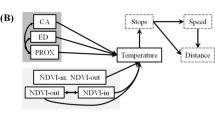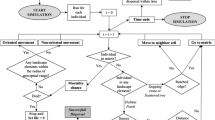Abstract
Although the impact of vegetation and other environmental factors on the distribution of terrestrial invertebrates has been known since the 1950s, basic knowledge about their interaction with micro-landscape elements is lacking. In experimental model systems, the impact of varying local spatial resistance (LSR) on the distribution of Tenebrio molitor individuals was analysed in the laboratory. In the setups, LSR led to a reduction of the average distance covered (move step length) and a reduction of the velocity (the maximum speed ranging from 36.1 in the control groups to 20.4 [mm*step−1] in areas with a maximum LSR). Also, the covered distances per individual varied among three groups, from 2.97 m in the control to 1.11 m in areas with medium LSR to 0.88 m in areas with maximum LSR. Thus, in areas with LSR, animals were forced by their habitats to perform shorter move steps on average and covered less distance. The distance covered (i.e., dispersal performances) were not correlated with such factors as sex, weight and length of the Tenebrio individuals from other studies. Analysis of the data for net squared displacement indicated that the dispersal of the beetles did not follow a diffusion process. The move step directions of the dispersal data showed pronounced autocorrelation, which means that in contrast to other findings, the individuals were not performing a random walk. This effect was strongly dependent on the temporal resolution (i.e. grain), and was also influenced by the experimental conditions. The entire array of data showed high variability among the sub-groups (as well as many outliers), revealing nonparametric characteristics. The results showed that the specific physical configuration of suitable habitat for Tenebrio is one of the key indicators of landscape connectivity on the micro-scale.
Similar content being viewed by others
References
H.G. Andrewartha and L.C. Birch: The Distribution and Abundance of Animals, The University of Chicago Press, Chicago, Illinois, 1954.
R. Levins: “Some demographic and genetic consequences of environmental heterogeneity for biological control”, Bull. Entom. Soc. Am., Vol. 15, (1969), pp. 237–240.
I. Hanski: “Single-species metapopulation dynamics: concepts, models, and observations”, Biol. J. Linn. Soc., Vol. 42, (1991), pp. 17–38.
P. Turchin: Quantitative Analysis of Movement: measuring and modeling population redistribution in plants and animals, Sinauer Associates, Sunderland, MA, 1998.
J.A. Wiens: “The landscape context of dispersal”, In: J. Clobert, E. Danchin, A.A. Dhondt and J.D. Nichols (Eds.): Dispersal: Individual, Population and community, Oxford University Press, Oxford, 2001, pp. 96–109.
K.A. With and T.O. Crist: “Critical Thresholds in Species Responses to Landscape Structure”, Ecology, Vol. 76(8), (1995), pp. 2446–2459.
N.E. McIntyre: “Scale-dependent habitat selection by the darkling beetle Eleodes hispilabris (Coleoptera: Tenebrionidae)”, Am. Midl. Nat., Vol. 138, (1997), pp. 230–235.
B. Breckling, H. Reuter H. and U. Middelhoff: “Self-organisation simplified: Simulating spatial structures which emerge from non-directed ecological interactions”, In: J. Sklenar (Ed.): Proceedings of the 26th ASU conference-Object oriented modelling and simulation, Malta, 2000, pp. 75–85.
N.L Cuong and M.B. Cohen: “Mating and dispersal behaviour of Scirpophaga incertulas and Chilo suppressalis (Lepidoptera; Pyralidae) in relation to resistance management for rice transformed with Bacillus thuringiensis toxin genes”, Int. J. Pest Manag., Vol. 49(4), (2003), pp. 275–279.
S. Boinski, L. Kauffman, E. Ehmke, S. Schet and A. Vreedzaam: “Dispersal patterns among three species of squirrel monkeys (Saimiri oerstedii, S. boliviensis and S. sciureus): I. Divergent costs and benefits”, Behaviour, Vol. 142(5), (2005), pp. 525–632.
T.R.E. Southwood: Ecological methods, Halsted Press, Chapman and Hall, London, 1978.
T.R.E Southwood and P.A. Henderson: Ecological methods, 3rd ed., Blackwell Science, Malden, Massachusetts, 2000.
A. Brauns: “Taschenbuch der Waldinsekten: Grundriß einer terrestrischen Bestandes-und Standort-Entomologie”, G. Fischer, Stuttgart, 1991.
K. Honomichl: “Biologie und Ökologie der Insekten-Ein Taschenlexikon von Werner Jacobs und Maximilian Renner”, Spektrum Akademischer Verlag, Heidelberg, 1998.
M. Pihaja, M. Koivula and J. Niemela: “Responses of boreal carabid beetle assemblages (Coleoptera, Carabidae) to clear-cutting and top-soil preparation”, Forest. Ecol. Manag., Vol. 222(1–3), (2006), pp. 182–190.
E. Sieren and F.P. Fischer: “Evaluation of measures for enlargement, renaturation and development of a dry grassland biotope by analysing differences in the carabid fauna (Coleoptera)”, Acta Oecol., Vol. 23(1), (2002), pp. 1–12.
B. Zodl and K.J. Wittmann: “Effects of sampling, preparation and defecation on metal concentrations in selected invertebrates at urban sites”, Chemosphere, Vol. 52(7) (2003), pp. 1095–1103.
F. Soldati and P. Leo: “Revision of French and Corsican species of the genus Asida Latreille, 1802 (Insecta: Coleoptera: Tenebrionidae)”, Ann. Zool., Vol. 55(3), (2005), pp. 335–373.
S. Scheu, D. Albers, J. Alphei, R. Buryn, U. Klages, S. Migge, C. Platner and J.A. Salamon: “The soil fauna community in pure and mixed stands of beech and spruce of different age: trophic structure and structuring forces”, Oikos, Vol. 101(2), (2003), pp. 225–238.
A. Sander, T. Purtauf, S. Holzhauer and V. Wolters: “Landscape Effects on the Genetic Structure of the Ground Beetle Poecilus versicolor STURM 1824”, Biodivers, Conserv., Vol. 15(1), (2006), pp. 245–259.
P.D. Taylor, L. Fahrig, K. Henein and G. Merriam: “Connectivity is a vital element of landscape structure”, Oikos, Vol. 68, (1993), pp. 571–573.
G. Merriam, K. Henein and K. Stuart-Smith: “Landscape dynamics models”, In: M.G. Turner and R.H. Gardner (Eds.): Quantitative Methods in Landscape Ecology, Springer-Verlag, New York, 1991, pp. 399–416.
J. Pither and P.D. Taylor: “An experimental assessment of landscape connectivity”, Oikos, Vol. 83, (1998), pp. 166–174.
J.A. Wiens: “Metapopulation dynamics and landscape ecology”, In: M. Gilpin and I. Hanski (Eds.): Metapopulation biology: ecology, genetics and evolution, Academic Press, 1997, pp. 43–62.
B. Heydemann: “Die Biotopstruktur als Raumwiderstand und Raumfülle für die Tierwelt”, Verh. Dtsch. Zool. Ges., (1957), pp. 332–347.
J.A. Wiens and B.T. Milne: “Scaling of ‘landscapes’ in landscape ecology, or landscape ecology from a bettle’s perspective”, Landscape Ecol., Vol. 3, (1989), pp. 87–96.
T.O. Crist, D.S. Guertin, J.A. Wiens and B.T. Milne: “Animal movements in heterogeneous landscapes: an experiment with Eleodes beetles in short grass prairie”, Funct. Ecol., Vol. 6, (1992), pp. 536–544.
J.A. Wiens, R.L. Schooley and R.D. Weeks: “Patchy landscapes and animal movements: do beetles percolate?” Oikos, Vol. 78, (1997), pp. 257–264.
P.M. Kareiva and N. Shigesada: “Analyzing insect movement as a correlated random walk”, Oecologia, Vol. 56, (1983), pp. 234–238.
J.M. Morales and S.P. Ellner: “Scaling up movements in heterogeneous landscapes: the importance of behavior”, Ecology, Vol. 83(8), (2002), pp. 2240–2247.
R.A. Ims: “Movement patterns related to spatial structures”, In: L. Hansson, L. Fahrig and G. Merriam (Eds.): Mosaic landscapes and ecological processes, Chapman and Hall, London, 1995, pp. 85–109.
J.M. Morales: “Behavior at habitat boundaries can produce leptokurtic movement distributions”, Am. Nat., Vol. 160(4), (2002), pp. 531–538.
F. Jopp and H. Reuter: “Dispersal of carabid beetles-emergence of distribution patterns”, Ecol. Mod., Vol. 186, (2005), pp. 389–405.
H. Kaiser: “Populationsdynamik und Eigenschaften einzelner Individuen”, Verh. Ges. Ökol., Vol. 4, (1975), pp. 25–38.
D.L. DeAngelis and L.J. Gross: Individual-Based Models And Approaches in Ecology, Chapman and Hall, New York, 1992.
R. Ihaka and R. Gentleman: “R: a language for data analysis and graphics”, J. Comput. Graph. Stat., Vol. 5, (1996), pp. 299–314.
V. Nordmeier, T. Kersting and W. Hahn: VIANA-3.64-automatical VIdeo ANAlysis, http://didaktik.physik.uni-essende/viana/, (2006).
F. Jopp: “Comparative studies on the dispersal of the Great Ramshorn Planorbarius corneus L. —A modelling approach”, Limnologica, Vol. 36, (2006), pp. 17–25.
F. Jopp: Empirical Studies and modeling approaches of invertebrates in a fen-wetland system, Thesis (PhD), Free University of Berlin, Berlin, 2003.
J.G. Skellam: “The formulation and interpretation of mathematical models of diffusional process in population biology”, In: M.S. Bartlett and R.W. Hiorns (Eds.): The mathematical theory of the Dynamic of Biological Populations, Academic Press, New York, 1973, pp. 63–85.
G. Bahrenberg, E. Giese and J. Nipper: “Statistische Methoden in der Geographie, Band 2 ‘Multivariate Statistik’”, Studienbücher Geographie, Stuttgart, Teubner, 1992.
D.A. Griffith: Advanced spatial statistics, Kluwer, Dordrecht, 1998.
R.R. Sokal and N.L. Oden: “Spatial autocorrelation in biology. I. Methodology”, Biol. J. Linn. Soc., Vol. 10, (1978), pp. 199–228.
S.J. Turner, R.V. O’Neill, W. Conley and H.C. Humphries: “Pattern and scale: statistics for landscape ecology”, In: M.G. Turner and R.H. Gardner (Eds.): Quantitative methods in landscape ecology, Springer-Verlag, New York, 1991, pp. 17–49.
J.C. Davis: Statistics and Data Analysis in Geology, John Wiley & Sons, New York, 1986.
M.L. Cain: “The analysis of angular data in ecological field studies”, Ecology, Vol. 70, (1989), pp. 1540–1543.
M.A. Baars: “Patterns of movement of radioactive Carabid beetles”, Oecologia, Vol. 44, (1979), pp. 125–140.
A.W. Lauterbach: “Verbreitungs-und aktivitätsbestimmende Faktoren bei Carabiden in sauerländischen Wäldern”, Abh. Land. Mus. Nat. Kd. Münst., Vol. 26(4), (1964), pp. 1–103.
F. Jopp and C. Lange: “Improving data interpretation of fragmentary data sets on invertebrate dispersal with permutation tests”, Acta Oecol., (2006), in print.
B. Breckling: “Uniqueness of ecosystems versus generalizability and predictability in ecology”, Ecol. Mod., Vol. 63, (1992), pp. 13–27.
B. Breckling and K. Mathes: “Systemmodelle in der Ökologie: Individuen-orientierte und kompartiment-bezogene Simulation, Anwendungen und Kritik”, Verh. Ges. Ökol., Vol. 19(3), (1991), pp. 635–646.
M.G. Turner and R.H. Gardner: Quantitative methods in landscape ecology, Springer-Verlag, New York, 1991.
Author information
Authors and Affiliations
About this article
Cite this article
Jopp, F. The impact of local spatial resistance on the movement behaviour of Tenebrio molitor L.. cent.eur.j.biol. 1, 412–429 (2006). https://doi.org/10.2478/s11535-006-0025-3
Received:
Accepted:
Issue Date:
DOI: https://doi.org/10.2478/s11535-006-0025-3




